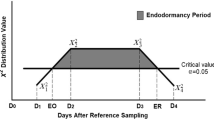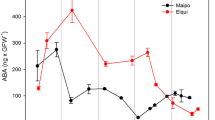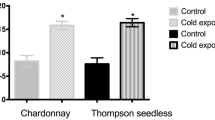Abstract
Statistical analysis of bud break data for grapevine (Vitis vinifera L. cvs. Riesling and Müller-Thurgau) at 13 sites along the northern boundary of commercial grapevine production in Europe revealed that, for all investigated sites, the heat summation method for bud break prediction can be improved if the starting date for the accumulation of heat units is specifically determined. Using the coefficient of variance as a criterion, a global minimum for each site can be identified, marking the optimum starting date. Furthermore, it was shown that the application of a threshold temperature for the heat summation method does not lead to an improved prediction of bud break. Using site-specific parameters, bud break of grapevine can be predicted with an accuracy of ± 2.5 days. Using average parameters, the prediction accuracy is reduced to ± 4.5 days, highlighting the sensitivity of the heat summation method to the quality and the representativeness of the driving temperature data.




Similar content being viewed by others

References
Abrami G (1972) Optimum mean temperature for plant growth calculated by a new method of summation. Ecology 53:893–900
Allen JC (1976) Modified sine wave method for calculating degree days. Environ Entomol 5:388–396
Alleweldt G (1960) Untersuchungen über den Austrieb der Winterknospen von Reben. Vitis 2:134–152
Alleweldt G (1967) Grapevine physiology. Research results 1961–1964. Vitis 6:63–81
Alleweldt G, Hofäcker W (1975) Einfluß von Umweltfaktoren auf Austrieb, Blüte, Fruchtbarkeit und Triebwachstum bei der Rebe. Vitis 14:103–115
Arnold CY (1960) Maximum-minimum temperatures as a basis for computing heat units. Proc Am Soc Hortic Sci 74:430–445
Baskerville GL, Emin P (1969) Rapid estimation of heat accumulation from maximum and minimum temperatures. Ecology 50:514–517
Besselat B, Drouet G, Palagos B (1995) Méthodologie pour déterminer le besoin thermique nécessaire au départ de la floraison de la vigne. J Int Sci Vigne Vin 29:171–182
Bidabe B (1965) Contrôle de l'époque de floraison du pommier par une nouvelle conception de l'action de températures. C R Acad Agric Fr 49:934–945
Bindi M, Miglietta F, Gozzini B, Orlandini S, Seghi L (1997) A simple model for simulation of growth and development in grapevine (Vitis vinifera L.). I. Model description. Vitis 36:67–71
Burckhardt F (1860) Über die Bestimmung des Vegetationsnullpunktes. Verh Naturforsch Ges Basel 2:47–62
Buttrose MS, Hale CR (1973) Effect of temperature on development of the grapevine inflorescence after bud burst. Am J Enol Vitic 24:14–16
Calo A, Zomasi D, Costacurta A, Biscaro S, Aldighiere R (1994) The effect of temperature thresholds on grapevine (Vitis spec.) bloom. An interpretative model. Riv Vitic Enol 47:3–14
Cannell MGR, Smith RI (1983) Thermal time, chill days and prediction of budburst in Picea sitchensis. J Appl Ecol 20:951–963
Cesaraccio C, Spano D, Snyder RL, Duce P (2004) Chilling and forcing model to predict bud-burst of crop and forest species. Agric For Meteorol 126:1–13
Cesaraccio C, Spano D, Snyder RL, Duce P (2005) Chilling and forcing model to predict bud-burst of crop and forest species (corrigendum to vol 126, 1–13, 2004). Agric For Meteorol 129:211–211
Christiansen P (1969) Seasonal changes and distribution of nutritional elements in Thompson Seedless grapevines. Am J Enol Vitic 20:176–190
Chuine I, Kramer K, Hänninen H (2003) Plant development models. In: Schwartz MD (ed) Phenology: an integrative environmental science. Kluwer, Dordrecht, pp 217–235
de Réaumur RAF (1735) Observations du thermomètre, faites à Paris pendant l'annee 1735, comparées avec celles qui ont été faites sous la ligne, á l'isle de France. á Alger et quelques unes des nos isles de l'Amérique. Memoires de l'Académie des Sciences de Paris
Dokoozlian NK (1999) Chilling temperature and duration interact on the budbreak of 'Perlette' grapevine cuttings. Hortscience 34:1054–1056
Due G, Morris M, Pattison S, Coombe BG (1993) Modeling grapevine phenology against weather—considerations based on a large data set. Agric For Metorol 65:91–106
Eckenrode CJ, Chapman RK (1972) Seasonal adult Cabbage Maggot Diptera-Anthomyiidae populations in field in relation to thermal unit accumulations. Ann Entomol Soc Am 65:151–156
Fennell A, Hoover E (1991) Photoperiod influences growth, bud dormancy, and cold acclimation in Vitis labruscana and V. riparia. J Am Soc Hortic Sci 116:270–273
García de Cortázar I, Brisson N, Gaudillere JP (2009) Performance of several models for predicting bud burst date of grapevine (Vitis vinifera L.). Int J Biometeorol 53:317–326
Gilbert N, Gutierrez AP (1973) Plant-aphid-parasite relationship. J Anim Ecol 42:323–337
Gutierrez AP, Williams DW, Kido H (1985) A model of grape growth and development: the mathematical structure and biological considerations. Crop Sci 25:721–728
Hänninen H (1990) Modelling bud dormancy release in trees from cool and temperate regions. Acta For Fenn 213:1–47
Hickin RP, Vittum MT (1976) Importance of soil and air temperature in spring phenoclimatic modeling. Int J Biometeorol 20:200–206
Horney G (1966) Die Vorhersage des Blühtermins der Reben. Weinberg Keller 13:263–273
Huglin P, Schneider C (1998) Biologie et écologie de la vigne. 2. Auflage. Lavoisier, Paris
Imaizumi T, Kay SA (2006) Photoperiodic control of flowering: not only by coincidence. Trends Plant Sci 11:550–558
Jimenez J, Ruiz V (1995) Phenological development of Vitis vinifera L. in Castilla - La Mancha (Spain)—a study of 21 cultivars (10 red and 11 white cultivars). Acta Hortic 388:105–110
Kramer K (1994) Selecting a model to predict the onset of growth of Fagus Sylvatica. J Appl Ecol 31:172–181
Kwon EY, Jung JE, Chung U, Yun JI, Park HS (2008) Using thermal time to simulate dormancy depth and bud-burst of vineyards in Korea for the twentieth century. J Appl Meteorol Climatol 47:1792–1801
Lachenbruch PA, Mickey MR (1968) Estimation of error rates in discriminant analysis. Technometrics 10:1–11
Lavee S, May P (1997) Dormancy of grapevine buds—facts and speculation. Aust J Grape Wine Res 3:31–46
Lindsey AA (1963) Accuracy of duration temperature summing and its use for Prunus Serrulata. Ecology 44:149–151
Lindsey AA, Newman JE (1956) Use of official weather data in spring time—temperature analysis of an Indiana phenological record. Ecology 37:812–823
Lopes J, Eiras-Dias JE, Abreu F, Climaco P, Cunha JP, Silvestre J (2008) Thermal requirements, duration and precocity of phenological stages of grapevine cultivars of the Portuguese collection. Cienc Tec Vitiv 23:61–71
Lorenz DH, Eichhorn KW, Bleiholder H, Klose R, Meier U, Weber E (1994) Phänologische Entwicklungsstadien der Weinrebe (Vitis vinifera L. ssp. vinifera). Vitic Enol Sci 49:66–70
Magoon CA, Culpepper CW (1932): Response of sweet corn to varying temperatures from time of planting to canning maturity. US Dep Agric Tech Bull 312
May P (1964) Über die Knospen- und Infloreszenzentwicklung der Rebe. Wein-Wiss 19:457–485
McIntyre GN, Kliewer WM, Lider LA (1987) Some limitations of the degree-day system as used in viticulture in California. Am J Enol Vitic 38:128–132
Moncur MW, Rattigan K, Mackenzie DH, McIntyre GN (1989) Base temperatures for budbreak and leaf appearance of grapevines. Am J Enol Vitic 40:21–26
Nendel C, Kersebaum KC (2004) A simple model approach to simulate nitrogen dynamics in vineyard soils. Ecol Model 177:1–15
Peyer E, Koblet W (1966) Der Einfluss der Temperatur und der Sonnenstunden auf den Blütezeitpunkt der Reben. Schweiz. Z. Obst-Weinbau 10:250–255
Pouget R (1988) Le débourrement des bourgeons de la vigne: méthode de prévision et principes d´établissement d´une échelle de précocité de débourrement. Connais Vigne Vin 22:105–123
Robertson GW (1968) A bio-meteorological time scale for a cereal crop involving day and night temperatures and photoperiod. Int J Biometeorol 12:191–223
Schnabel BJ, Wample RL (1987) Dormancy and cold hardiness in Vitis vinifera L. cv. White Riesling as influenced by photoperiod and temperature. Am J Enol Vitic 38:265–272
Sevacherian V, Stern VM, Mueller AJ (1977) Heat accumulation for timing Lygus (Hemiptera-(Heteroptera)-Miridae) control measures in a safflower-cotton complex. J Econ Entomol 70:399–402
Tesic D, Woolley DJ, Hewett EW, Martin DJ (2002) Environmental effects on cv Cabernet Sauvignon (Vitis vinifera L.) grown in Hawke's Bay, New Zealand. 1. Phenology and characterisation of viticultural environments. Aust J Grape Wine Res 8:15–26
Tisserand E (1875) Mémoire sur la végétation dans les hautes latitudes. Mémoires de la Société Central d'Agriculture Bouchard-Huzard, Paris, p 271
Trejo-Martínez MA, Orozco JA, Maguer-Vargas G, Carvajal-Millan E, Gardea AA (2009) Metabolic activity of low chilling grapevine buds forced to break. Thermochim Acta 481:28–31
Wermelinger B, Baumgärtner J, Gutierrez AP (1991) A demographic model of assimilation and allocation of carbon and nitrogen in grapevines. Ecol Model 53:1–26
Wielgolaski FE (1999) Starting dates and basic temperatures in phenological observations of plants. Int J Biometeorol 42:158–168
Williams DW, Andris HL, Beede RH, Luvisi DA, Norton MVK, Williams LE (1985) Validation of a model for the growth and development of the Thompson Seedless grapevine. II. Phenology. Am J Enol Vitic 36:283–289
Winkler AJ (1962) General viticulture. University of California Press, Berkeley
Wolfart A, Bogenrieder A, Becker N (1988) Climate and vine phenology—evaluation of a long-term series of observations at three locations near Freiburg in Breisgau. Mitt Klosterneuburg 38:108–119
Zalom FG, Goodell PB, Wilson LT, Barnett WW, Bentley WJ (1983) Degree-days: the calculation and use of heat units in pest management. Division Agriculture and Natural Resources, University of California, Berkeley
Acknowledgements
The author gratefully acknowledges the contribution of the German Viticulture Research facilities in Bad Kreuznach (E. Müller), Bernkastel-Kues (M. Maixner), Freiburg (H.J. Stuecklin), Oppenheim (J. Wagenitz), Neustadt a.d.W. (B. Ziegler), Trier (E. Kohl), Veitshöchheim (H. Hofmann) and Weinsberg (D. Rupp), of the Institute for Physics and Meteorology at Hohenheim University, Germany (I. Henning-Müller), of the Viticulture Research Institute of Remich, Luxemburg (S. Fischer), of the Slovak Hydrometeorological Institute at Bratislava (P. Nejedlik), of the Czech Hydrometerological Institute at Ústí nad Labem (L. Hájková) and of INRA-Agroclim, France (I. Garcia de Cortazar). Furthermore, many thanks are expressed to F.-M. Chmielewski (Humboldt-University of Berlin) and to I. Garcia de Cortazar for valuable comments on the chosen approach.
Author information
Authors and Affiliations
Corresponding author
Rights and permissions
About this article
Cite this article
Nendel, C. Grapevine bud break prediction for cool winter climates. Int J Biometeorol 54, 231–241 (2010). https://doi.org/10.1007/s00484-009-0274-8
Received:
Revised:
Accepted:
Published:
Issue Date:
DOI: https://doi.org/10.1007/s00484-009-0274-8



